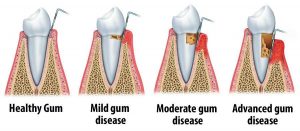Periodontics is a branch of dentistry that deals with diseases of the supporting structures of the teeth, including the gums and bone.
The periodontist deals with the prevention, diagnosis, and treatment of periodontal disease (gum and bone treatment)
The periodontist examines the gums, checks to see if there is any gum line recession, assesses how the teeth fit together when biting, and checks the teeth to see if any are loose.
The periodontist will also take a small measuring instrument called a probe and place it between the teeth and gums to determine the depth of those spaces, known as periodontal pockets. This helps the periodontist assess the health of the gums. X-rays may also be taken to observe the health of the bone below the gum line.

Persistent bleeding gums in most cases are a sign of gum disease (gingivitis). Gingivitis is the earliest form of the start of periodontal disease. It causes the gums to become red, swollen, and bleed easily. There is usually little or no discomfort at this stage.
Gingivitis is often caused by inadequate oral hygiene. Gingivitis is reversible with professional treatment and good oral home care.
Untreated gingivitis can advance to periodontitis. With time, plaque can spread and grow below the gum line. Toxins produced by the bacteria in plaque irritate the gums. The toxins stimulate inflammatory response and the tissues and bone that support the teeth are broken down and destroyed.
Gums separate from the teeth, forming pockets (spaces between the teeth and gums) that become infected. As the disease progresses, the pockets deepen and more gum tissue and bone are destroyed. The deeper the pocket becomes, the more rapid the progression of this disease. The teeth can become loose and may eventually have to be removed.
Scaling is a careful cleaning of the root surfaces to remove plaque and calculus (tartar) from deep periodontal pockets and to smooth the tooth root to remove bacterial toxins.
Most periodontists would agree that after non-surgical debridement (deep scaling) many patients do not require any further active treatment. If further treatment is required, then the periodontist will discuss this with you and this may involve surgery. However, the majority of patients will only require ongoing maintenance therapy with a hygienist.
You may have asked your periodontist about procedures to improve a “gummy” smile because your teeth appear short. Your teeth may actually be the proper length, but they’re covered with too much gum tissue. To correct this, your periodontist may perform a dental crown-lengthening procedure.
During the dental crown lengthening procedure, excess gum and bone tissue is reshaped to expose more of the natural tooth. This can be done to one tooth, to even your gum line, or to several teeth to expose a natural, broad smile. For dark gums, the top layer of the gums can be scrapped to then allow the gum to heal as a lighter colour.
Pocket reduction surgery (also known as gingivectomy, osseous surgery, and flap surgery) is a collective term for a series of several different surgeries aimed at gaining access to the root of the teeth in order to remove bacteria and tartar (calculus).
Pocket reduction surgery is a common periodontal procedure which has been proven effective at eliminating bacteria, reducing inflammation, and saving teeth. The goals of pocket reduction surgery are: Reducing bacterial spread, halting bone loss, facilitate home care, enhancing the smile.
This common surgery involves lifting back the gums and removing the tartar. The gums are then sutured back in place so that the tissue fits snugly around the tooth again. After surgery, the gums will heal and fit more tightly around the tooth. This sometimes results in the teeth appearing longer.
In addition to flap surgery, if needed, your periodontist or dentist may suggest procedures to help regenerate any bone or gum tissue lost to periodontitis. Bone grafting, in which natural or synthetic bone is placed in the area of bone loss, can help promote bone growth.
A technique that can be used with bone grafting is called guided tissue regeneration. In this procedure, a small piece of mesh-like material is inserted between the bone and gum tissue. This keeps the gum tissue from growing into the area where the bone should be, allowing the bone and connective tissue to regrow.
Growth factors – proteins that can help your body naturally regrow bone – may also be used. In cases where gum tissue has been lost, your dentist or periodontist may suggest a soft tissue graft, in which synthetic material or tissue taken from another area of your mouth is used to cover exposed tooth roots.
Your general dental practitioner may be able to do some basic periodontal treatment, but if the problem is more severe, you may need to see an periodontist, who will carry out the advanced treatment that requires further specialist care and is not usually available in general dental practice.
Our Periodontists are registered on the General Dental Council (GDC) register as Specialists, or have a special interest in Periodontics (trainee specialists). They have spent several additional years studying this specialty after finishing their dental degree (postgraduate training).

